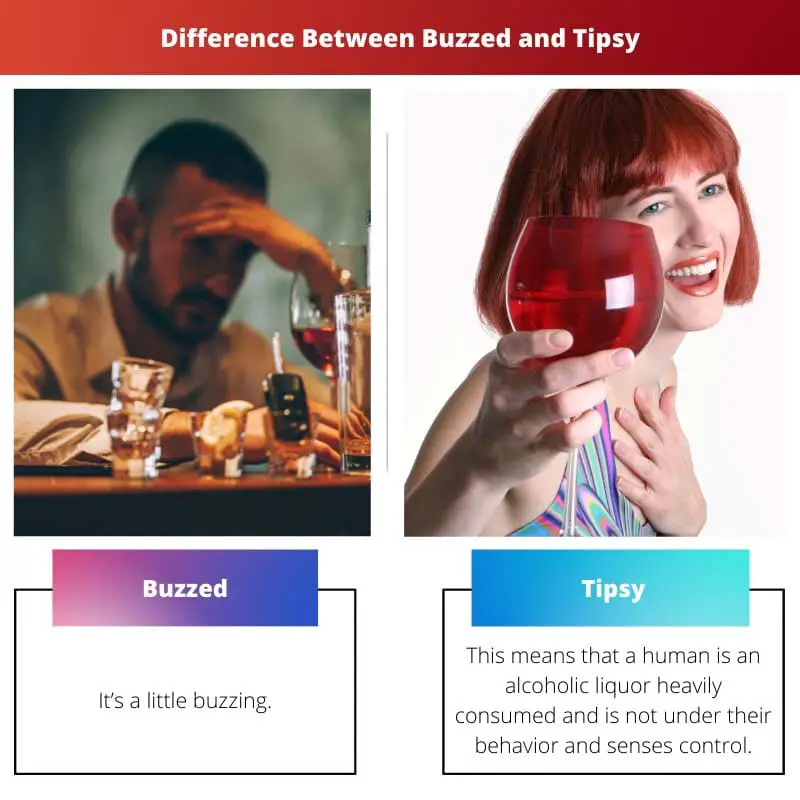People go through several stages when drinking alcohol. The first thing to do is to be happy. People are pleased, the mood is higher, the hemmings are reduced, the atmosphere around them is warm and friendly, and they become euphoric.
They arrive at the point where they can do without their alcohol level, something they can not do. Whenever it feels alright and positive, and the entire body relaxes is considered a stubborn period after alcohol intake.
There’s no official “tipsy” or “buzzed” description, but people always recall all they did or did at a tinkering stage. The spirit begins to function, and a person’s senses are relieved.
Key Takeaways
- Buzzed is a calm state of drunkenness where the person may feel relaxed and slightly euphoric. At the same time, Tipsy is a more pronounced state of intoxication where the person may experience impaired judgment and coordination.
- Buzzed is the result of low to moderate alcohol consumption, while Tipsy is the result of higher alcohol consumption.
- Buzzed can be considered safe for driving, while Tipsy is unsafe for driving or operating machinery.
Buzzed vs Tipsy
Buzzed and tipsy are used to refer to intoxication. When an individual feels a loss of balance and is having difficulty standing, the term tipsy refers to such a state. The buzzed is the more progressed state of drunkenness, where an individual completely feels lost and loses control over him/herself.

Buzzed can be tricky if your face is red and you feel wet, comfortable, and trusted. It is said that people who have stubbornness have not “gone over” yet. This is because they think. They get buzzed when they do.
The clinical implications indicate that a person consumes a combination of time and amount of alcohol. When people eat 3 or 4 drinks in an hour, they would be likely to be whirlwind.
Tipsy is the first stage of the body’s system to consume alcohol. This is how you act when you know you are no longer quite sober. Ethanol is the addictive component of alcohol. It will also be hard to avoid drinking.
You hit step 2, which is considered tipsy when you drink too much. Clinically, the alcohol is immediately affected by the bloodstream and reacts steadily.
Comparison Table
| Parameters of Comparison | Buzzed | Tipsy |
|---|---|---|
| Define | It’s a little buzzing. | This means that a human is an alcoholic liquor heavily consumed and is not under their behavior and senses control. |
| Consciousness | The subconscious is left confused and blacked out at times. | Both inhibitions are lost aside by the mind. |
| Effects | An individual may find it difficult to walk properly at this point. Body balance will be lost—body coordination. | An individual at this point will be associated with topics that he or she doesn’t speak and be assured of. |
| Cycle | Buzzed is the advanced stage of drinking intoxication. | Tipsy is the start of alcohol intoxication. |
| Blood Alcohol Content | Over 0.18 to 0.30 | From 0.03 to 0.12% |
What is Buzzed?
This is the mature phase of alcoholic drink consumption. This stage is achieved as he/she consumes more than five or six drinks, depending on the potential of a person’s body.
The clinical implications indicate that a person consumes a combination of time and amount of alcohol. When people eat 3 or 4 drinks in an hour, they would be likely to be whirlwind.
Buzzed can be tricky if your face is red and you feel wet, comfortable, and trusted. It is said that people who have stubbornness have not “gone over” yet. This is because they think.
Anyone drinking 4 or 5 drinks within 2 or 3 hours can remain sober at the same time. It is also a stage where an individual’s ability and number of drinks, along with the time factor, are important.
In the buzzing stage, the level of Blood-Alcohol is 0.18% to 0.30%. This is the next stage after Tipsy and can quickly be associated with the behavior of a human.
Considering that the buzzing is the most poisonous phase in which a person is drinking excessively.

What is Tipsy?
Tipsy is an early stage of intoxication due to alcoholic drink consumption. The ability and acceptance of alcohol depend on the body, as this stage comes between consuming 2 to 3 glasses of mixed alcohol.
This is an hour after a person has consumed the drink. At this point, the individual is very optimistic.
Clinically, the alcohol is immediately affected by the bloodstream and reacts steadily. Tipsy is the point where the impulses first respond when the alcohol works on the brain.
Tipsy is the first stage of the body’s system to consume alcohol. This is how you act when you know you are no longer quite sober. Ethanol is the addictive component of alcohol.
Blood Alcohol Containment (BAC) is used to determine how much alcohol levels in the bloodstream are mixed. A person in the tips stage has 0.03% to 0.12% of BAC.
An individual’s behavior can easily be categorized into two extremes of intoxicated periods. Tipsy is one of them.

Main Differences Between Buzzed and Tipsy
- Tipsy is the first explosion of pleasure and joy from an alcoholic overdose in your bloodstream, whereas when you are buzzed, the near-final stage of poisoning is when you lose your senses entirely or in half.
- Tipsy is the point where you can drink longer, whereas when you avoid drinking at a buzzing stage.
- The BAC levels of a Tipsy range from 0.03% to 0.12%, whereas the BAC levels of a buzzing person range from 0.18% to 0.30
- A guy with tipsy seems very tumultuous and talkative. Losing his senses because he can’t even balance his body, standing or going around, whereas the mind is better intoxicated by giving away all the inhibitions and making a person feel very secure, while the buzzing stage causes mental and emotional uncertainty.
- Tipsy is the start of alcohol intoxication, whereas buzzed is the advanced stage of drinking intoxication.


The detailed explanation of what being buzzed and tipsy entails provides a valuable insight into the potential risks involved. It emphasizes the importance of responsible consumption of alcohol.
I completely agree—this article highlights the significance of understanding the effects of alcohol at different stages of intoxication and underscores the need for responsible drinking.
The article certainly provides a compelling argument for moderation and awareness regarding alcohol consumption, particularly when it comes to recognizing the stages of buzzed and tipsy.
The comparison between the effects and consciousness associated with being buzzed and tipsy is a valuable component of this article. It emphasizes the need to recognize and address intoxication levels.
I agree wholeheartedly. The article provides a clear and detailed breakdown of the differences in alcohol intoxication stages, thereby highlighting the importance of vigilance and awareness.
The article offers a comprehensive understanding of the signs and risks involved in being buzzed and tipsy. It’s a reminder to be mindful of alcohol consumption and its potential consequences.
Completely agree. This article provides a detailed analysis of the stages of inebriation, emphasizing the need to exercise caution and restraint when consuming alcohol.
The article brings to light the importance of self-awareness and informed decision-making regarding alcohol consumption. Understanding the phases of buzzed and tipsy is key to responsible drinking.
The distinction made between the levels of alcohol consumption that lead to being buzzed and tipsy is crucial. It’s essential to know the differences to make informed decisions when drinking.
Absolutely, understanding the stage at which one crosses from buzzed to tipsy and the associated effects is valuable information for anyone who consumes alcohol.
The comparison table provided between buzzed and tipsy is very useful. It clarifies the key differences and characteristics of these stages, making it easier to identify and understand them.
I particularly appreciate the focus on consciousness and effects. It helps in recognizing the behavioral and cognitive changes associated with both buzzed and tipsy states.
I found the table to be extremely informative as well. It presents the details concisely and is a great reference for understanding the nuances of being buzzed and tipsy.
Understanding the blood alcohol content levels associated with being buzzed and tipsy is crucial. This article provides a comprehensive insight into these stages, and their potential dangers.
I completely agree with James. Having a clear understanding of what buzzed and tipsy really mean can aid in making informed decisions when drinking alcohol.
Absolutely, knowing the legal limits and recognizing the physical and mental symptoms of different degrees of intoxication can help prevent accidents and mishaps.
This is a very enlightening and thorough explanation of alcohol consumption phases, and the effects of being buzzed and tipsy. It’s important to understand the difference and know the signs to keep ourselves and the people around us safe.
I totally agree. The article makes a clear distinction between being buzzed and tipsy and the importance of recognizing the signs to ensure safety.
The article effectively highlights the physical and psychological effects of being buzzed and tipsy. It’s a wake-up call to be conscious of one’s alcohol consumption and its potential impact.
I couldn’t agree more. The article underscores the need for self-awareness and vigilance when it comes to alcohol intake, especially regarding buzzed and tipsy states.
The insights provided regarding the behavioral changes and intoxication levels associated with being buzzed and tipsy are crucial. It’s essential to be informed about these stages to ensure safety.
Absolutely, the article serves as a valuable resource for understanding the signs and dangers of alcohol intoxication, particularly when it comes to differentiating between being buzzed and tipsy.
The comprehensive explanation of the characteristics of being buzzed and tipsy provides a compelling case for cautious and responsible alcohol consumption. It’s crucial to remember the potential risks involved.
The article effectively emphasizes the significance of recognizing the different levels of alcohol intoxication, particularly in distinguishing between being buzzed and tipsy. It’s an essential read for anyone who consumes alcohol.
Absolutely. This article serves as a valuable guide for understanding the stages of alcohol intoxication and the associated implications, reminding us of the importance of moderation and awareness.